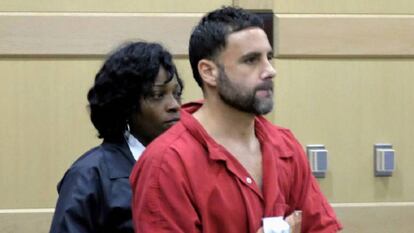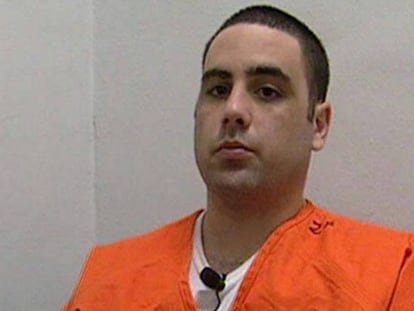New DNA evidence provides twist to retrial of Spaniard released from death row
Lawyers for Pablo Ibar, in prison since 1994 over a triple murder, said it is a partial match
The unearthing of new DNA evidence in the run-up to a retrial of Pablo Ibar, the Spaniard who spent 15 years on death row in the United States for a triple murder, has provided a new twist to a story dating back to 1994.
Ibar, a dual Spanish-American citizen, was convicted of a triple homicide of a nightclub owner and two models. He has already served 22 years in prison, but has always insisted on his innocence.
In February, the Florida Supreme Court ordered a retrial after accepting that mistakes were made by Ibar’s defense attorney during his first trial in 2000 and that the evidence presented in court was “weak.”
The key piece of evidence in the prosecution’s case was a grainy, soundless home security video
The key piece of evidence in the prosecution’s case was a grainy, soundless home security video that showed a group of men attacking nightclub owner Casimir “Butch Casey” Sucharski, and two models, Sharon Anderson and Marie Rogers, whom he had brought to his home in Miramar, Florida.
The three were shot and killed during the botched robbery attempt.
One of the suspects in the video appears to be Ibar, but according to his lawyers, no DNA evidence or fingerprints were found at the crime scene to connect Ibar with the murders.
In a bid to link Ibar to the crime definitively, public prosecutors in Florida have carried out four DNA analyses over the last 22 years, each one failing to link him to the killings. Three weeks ago, they asked for a fifth, which Ibar agreed to.
The results of the latest tests coincide “partially” with Ibar’s DNA, says his lawyer, Benjamin Waxman. Of the 15 loci – the specific location or position of a gene’s DNA sequence on a chromosome – that were analyzed, five coincide with Ibar’s DNA. The other 10 are too damaged to be tested.
Public prosecutors in Florida have carried out four DNA analyses over the last 22 years
“This is very weak evidence,” says Andrés Krakenberger, head of the Pablo Ibar Association, a Spain-based organization set up to lobby for the Spaniard’s release. “They have analyzed three stains on the t-shirt the killer used to hide his face and which was found at the crime scene. Two of them, the biggest, do not coincide with Pablo’s DNA. There is a third, which is tiny, that partially coincides,” he says.
Krakenberger says that the evidence is far from conclusive, pointing out that any items of Ibar’s clothing have already been analyzed over the last two decades.
“This isn’t the first time there has been contamination in Florida’s laboratories,” says Krakenberger, adding: “We are sure that this won’t hold up in court.”
“The t-shirt was used to cover the killer’s face. He wiped sweat off with it. If it had been Pablo’s, it would be covered with his DNA,” says Krakenberger.
Ibar’s retrial will take place next year. No date has been set. Seth Peñalver, accused of taking part in the killings, was cleared in 2012 after a retrial and spending 12 years on death row.
English version by Nick Lyne
Tu suscripción se está usando en otro dispositivo
¿Quieres añadir otro usuario a tu suscripción?
Si continúas leyendo en este dispositivo, no se podrá leer en el otro.
FlechaTu suscripción se está usando en otro dispositivo y solo puedes acceder a EL PAÍS desde un dispositivo a la vez.
Si quieres compartir tu cuenta, cambia tu suscripción a la modalidad Premium, así podrás añadir otro usuario. Cada uno accederá con su propia cuenta de email, lo que os permitirá personalizar vuestra experiencia en EL PAÍS.
¿Tienes una suscripción de empresa? Accede aquí para contratar más cuentas.
En el caso de no saber quién está usando tu cuenta, te recomendamos cambiar tu contraseña aquí.
Si decides continuar compartiendo tu cuenta, este mensaje se mostrará en tu dispositivo y en el de la otra persona que está usando tu cuenta de forma indefinida, afectando a tu experiencia de lectura. Puedes consultar aquí los términos y condiciones de la suscripción digital.
More information
Archived In
Últimas noticias
Most viewed
- Alain Aspect, Nobel laureate in physics: ‘Einstein was so smart that he would have had to recognize quantum entanglement’
- Alvin Hellerstein, a 92-year-old judge appointed by Bill Clinton, to preside over Maduro’s trial in New York
- Gilles Lipovetsky: ‘If you want to live better and fall in love, take Prozac, don’t look to philosophy’
- Cuba confirms death of 32 of its citizens in the US attack against Venezuela
- Why oil has been at the center of Venezuela-US conflicts for decades











































